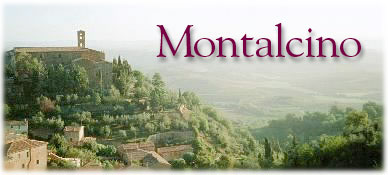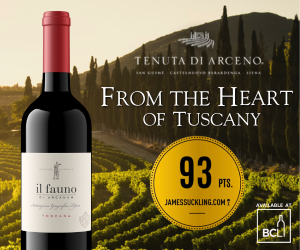Do you dream of firm, lean, hard-bodied wines with dry, tannic, earthy/tobacco aromas and flavours?
Or do you prefer voluptuous, round, balanced wines with ripe, black cherry fruit and smoky/gamey, plum and licorice aromas wrapped in a spicy, toasted-vanilla jacket? If you answered the latter, welcome to the sensational 1997 Brunello vintage.
The Montalcino region is awash in a multitude of ridges and valleys and a diversity of altitude, soil types and slope orientation makes for a variety of meso-climates.
With so many unique sites it's easy to understand the differing amounts of tannin, fruit aromas and flavours that make up your average Brunello and why even in a&fabulous vintage such as 1997 you can encounter everything from the dry and lean to the round and supple.
Not every Brunello was perfect in 1997 but many are ripe, elegant and balanced. Most offer mid-term aging possibilities but will be drinkable in the next year or two and certainly over the next 5 to 12 years.
The accolades for the '97 vintage are coming from many sources including the padrones of the Brunello region who feel that it may be the best of the 20th century.
Given the short life of mainstream Brunello (it's only been produced in any quantity since the 1960s) that puts it ahead of the likes of the great 1985, 1990 and 1995 vintages.
The difference in 1997 (and more recent vintages) is the overall consistent quality of the wine across the region. It's generally more appealing or drinkable in nature with more fruit concentration, riper tannins and better overall balance.
The improvements are due to several factors although the most important include: better clonal selections, lower yields, and new legislation changes following the 1995 vintage that were officially enacted in June 1998.
Brunello now spends a minimum of two years in wood, one year less than previously required. The same applies to the riserva although it is required to have an additional year's bottle aging before release versus the regular label. (The previous law required a minimum of 3 years ageing in wood and four months in bottle).
The manner in which the oak is used is also much improved. Many producers are using new barriques although often the sangiovese can quickly become over-oaked. Consequently, some winemakers have turned to using hogsheads (300L), tonneau (500 L), and newer upright tanks of 30-100 HL to blend and age various lots.
Despite a majority of older (120 HL) ovals in the region the more progressive winemakers are employing a blend of woods (new and old big and small) to define their personal style and complexity.
There are still lots of heavily oaked examples as well as fine quality wines exhibiting little or no oak. The trick is to balance the oak, vintage by vintage, to better satisfy the international palate.
The more interesting debate in Brunello is the one that revolves around the production of a single Brunello versus a regular and a riserva. The pricing and volume of one excellent wine should generate the same profit for the producer and simplify marketing as well as improve the quality of the Rosso category.
Most important it could take the Brunello category to new heights something that is unlikely to happen under the present system with so many sub-standard riservas in the marketplace.
Today the total vineyard area devoted strictly to Brunello is about 1,450 hectares. The typical vineyard size is extremely small with 66 per cent of the vineyards at Montalcino 5 hectares or less; 81 per cent under 15 hectares in size. There are some 210 growers of which 141 bottle their own wine.
Currently one hectare of Brunello vineyard is valued at 210,000 euros or essentially $200,000 US - similar to prices in Napa and Chateâuneuf du Pape, leaving many producers to blend sangiovese, cabernet, merlot and syrah in varying degrees under the IGT designation to grow their businesses and hopefully stem the ever rising price of Brunello.
Rosso di Montalcino or "baby" Brunello is an excellent product with some examples rivalling regular Brunello for quality. Unfortunately prices are closing in on half that of Brunello or more leaving one to wonder whether consumers will have any appetite for a second wine at such high prices.
At the annual new release tasting in Montalcino, Italy in February, 2002 there were some 120 Brunello labels available for evaluation. In Canada, you should be on the look out for the following 1997 labels expected to be released this fall:
(93) Ciacci Piccolomini D'Aragona; (92) Siro Pacenti; (92) Banfi 'Poggio all'Oro' Riserva; (91) Castello di Monastero 'Coldisole'; (91) Pertimali Sassetti Livio; (90) Fattoria dei Barbi 'Vigna del Fiore'; (90) La Poderina; (90) Tenuta Greppone Mazzi (Ruffino); (89) Pian delle Vigne (Antinori); (88) Col D'Orcia; (88) Il Poggione.
Finally, remember to decant young Brunello for at least 30 minutes to an hour before drinking which allow the aromas to open and the tannins to soften somewhat. Otherwise, the wines will seem quite closed and dry.
If you are going to drink young Brunello, even aged, they are best matched with grilled and roasted red meats (beef and game meats), fowl, mushrooms and truffles. Those who prefer their Brunello young may wish to try their wine accompanied by aged goat cheeses or a well-aged piece of Parmigiano-Reggiano.

 quicksearch
quicksearch






